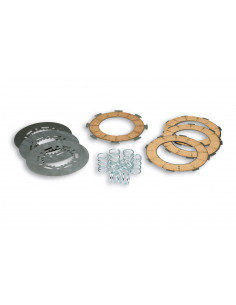- News
- 626 visualizaciones

Types of clutches for motorcycles
There are three types of clutches for motorcycles: dry, wet or multi-disc.
Depending on which one you choose, you can enjoy some advantages or others.
Look at them!
Dry clutch: advantages and disadvantages
Dry clutches are larger than wet ones and are also characterized by the fact that they require air cooling.
They have the advantage of having greater durability and also creating greater friction, thus offering a much better transmission and are also generally used in high performance engines.
In addition, they are less polluting because the gases released by wear are not released.
On the other hand, they are more effective and easier to preserve.
As we have already noted, dry clutches are normally seen on racing motorcycles, as they sustain many revolutions per minute.
Multi-disc clutch: advantages and disadvantages
This is a clutch that uses thin discs instead of a conventional disc, which fit together.
This disc drive is equipped with coil springs that allow the drum and hub to move synchronously.
This clutch is immersed in oil for better performance, making it possible to be much more progressive.
The gear change is faster and lighter.
Wet clutch: advantages and disadvantages
Wet clutches are mostly defined by being immersed in oil, which makes them completely covered and virtually noiseless.
They are one of the most common options on commercial motorcycles and are usually smaller in size.
These clutches have the advantage of being more resistant, as well as being more progressive, since the sensation when changing gears is smoother.
On the other hand, wet clutches are more difficult and expensive to maintain.
Furthermore, since they are bathed in oil, they work at higher temperatures and require monitoring of viscosity or thickness specifications so that the clutch does not slip.
Tips to treat your motorcycle's clutch
To avoid any type of unwanted problem with your clutch, it is very important that you comply with some basic notions to deal with it.
If you want to extend the life of this part, you will have to look at its driving design to make sure it is appropriate.
To use the clutch correctly you must change gear when it is fully pressed, otherwise you will wear it out and it will break sooner.
On the other hand, the use of quality products also comes into play.
For example, if a better oil is used, this may delay the need to change the part again.
When to change the motorcycle clutch
Constant use causes the clutch to break and require replacement after a while.
Experts advise replacing it every 15,000 kilometers or, at most, every 25,000 kilometers.
However, we should not let it go because clutch failure can cause the failure of other components and some really important ones, such as the engine.
How to change the motorcycle clutch
When it comes to changing the clutch on your motorcycle, it is best to go to a main workshop to avoid any type of problem.
Discover the best clutches for your motorcycle here at Rebesa.

